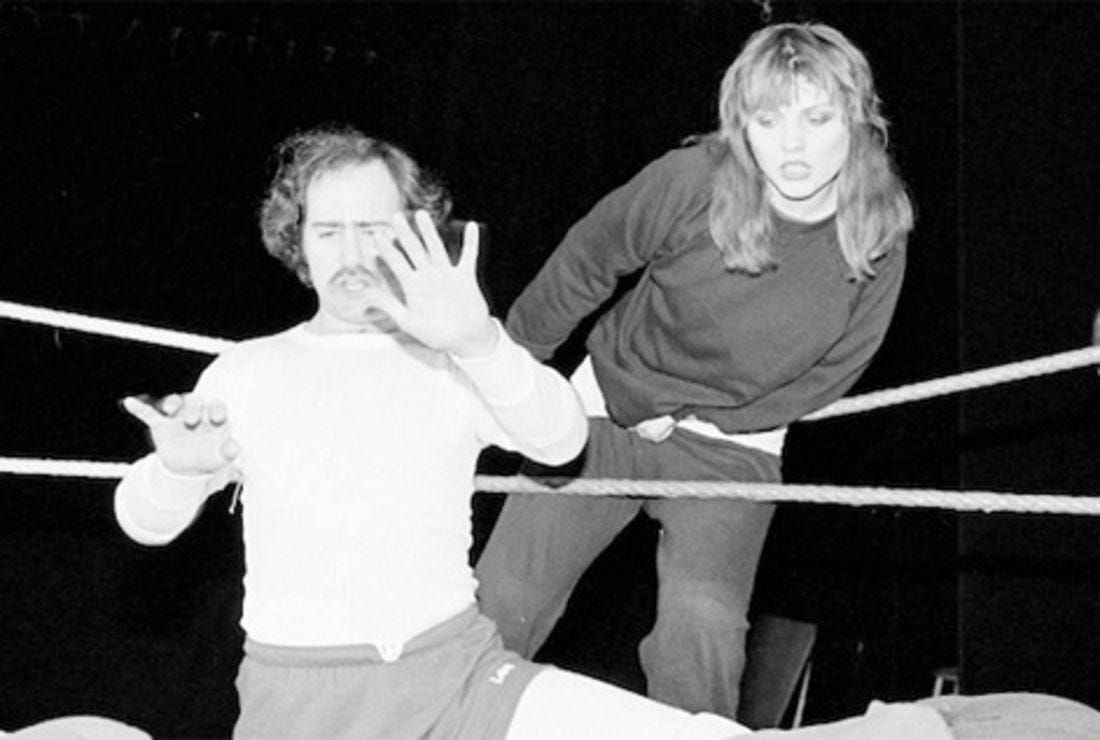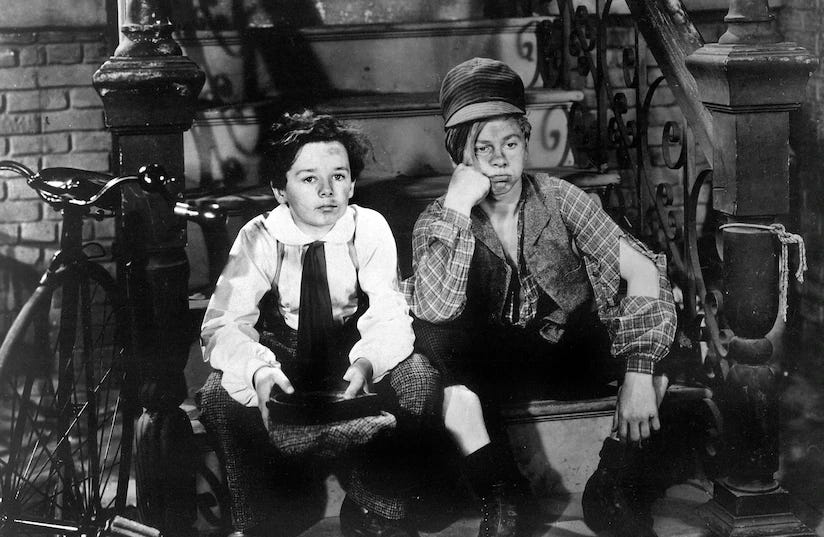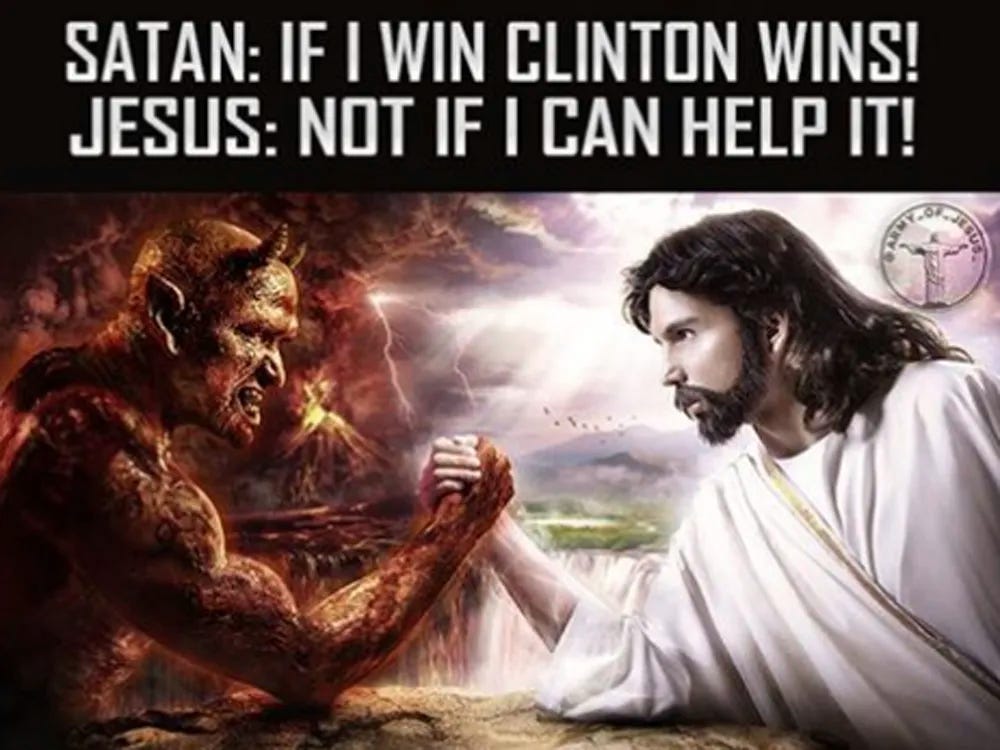On Metaphor and Kayfabe
Editor’s Note: I sometimes think observational candor can save the world. When I first met Gregory Alan Thornbury over dinner in Jackson, Tennessee twelve years ago, he kept addressing me as “David Dark,” which was disarming and hilarious and wildly inspiring. I didn’t feel like he was showing me all his cards, but I felt like he wanted to. He had his eyes and ears on certain dramas I couldn’t quite see, and it was as if he was observing me closely to see if I saw them too while drawing me in like a narrator or a stage manager. He wanted to play and he knew I wanted to play, and I didn’t see him again for a few years, but there was an energy between us that existed that evening and kept right on emanating. I’m still finding words for it, but I think of the energy as a summons to (or a conjuring of) the risk and goodwill of observational candor. I’m usually trying to talk myself and others into it, and I’ve found that Gregory is too. I think we kind of do this for each other.
Editor’s Note Continued: Gregory introduced me to the word “kayfabe” a few weeks back which brought a number of witnesses I’ve thought about for most of my life into focus. It also helped me in having more compassion for people who, I imagine, never planned to act and speak like bigots for a living but who, through many perceived pressure points and career decisions, are now abiding or are directly complicit in a disinformation pipeline that markets itself as Christian while threatening to destroy every form of human thoughtfulness. As a former alleged insider, Gregory know the ends and outs of this situation like very few people in the world. In time, folks employed by media outlets will, I suspect, draw on his knowledge and expertise at great length. But, for now, he’s someone who knows too much to be useful to industries that run on reaction and oversimplification. I am deeply honored to share his work here. Like Spinoza or Kierkegaard or Kaufman, Gregory offers light which will illumine what we’re all going through if we’ll let it. Please share, discuss, and/or differ aloud while receiving his witness.
On Metaphor and Kayfabe
Gregory Alan Thornbury
In my biography on Larry Norman, I drew attention to a phrase that the pied piper of the Jesus Movement often deployed in correspondence to colleagues and friends of his who were, perhaps, overly earnest in their hurry to do something concrete for “the Lord.”
“Metaphors be with you...” he would write, hoping that somehow he might persuade others to join him in a creative life in pursuit of peace as opposed to one hellbent on propaganda – the sworn enemy of art.
Over the course of my own life and career, I’ve felt the tension myself between art and propaganda. People who see themselves as “orthodox” of any stripe (theologically, politically, constitutionally) find metaphors unnerving, uncertain, and even unsafe. “Let us not mock God with metaphor,” John Updike wrote in his poem Seven Stanzas at Easter.
I myself used to applaud the sentiment until I paused for a moment to think about how monstrous the Bible itself would be if it were stripped of metaphor. Did the poet mean for his beloved to take literally “your nose is like the tower of Lebanon”? (Song of Songs 7:4) The mind boggles.
When you say unthoughtful things like I always heard growing up such as “Why I Believe the Bible is Literally True,” you might wind up being a racist like W.A. Criswell, the fundamentalist Southern Baptist pastor from First Baptist Dallas who tub-thumped around this theme his whole life. Read through certain spectacles, there’s a ton of racialist and nationalist themes tracking throughout the Bible just waiting for your literal interpretation.
At other times, having a metaphorical imagination could spell the difference between life and death. So when Donald Trump stood on that platform on Pennsylvania Avenue on January 6th, and said “If you don’t fight, you’re not going to have a country,” let’s just say he wasn’t speaking to people who saw the threat in an “inner jihad” sort of way. No, they likely conjured up images from Scriptures such as the “conquest of Canaan” in which Joshua took instructions from Yahweh to wipe out every man, woman, and child. After all, Deuteronomy 20:17 does say, “You shall not leave anything alive that breathes.”
If you forgo metaphor, you’ll likely take the word “storm” on a message board to imply violence and bloodshed. Just make sure you sing praise songs and pray before you do so, as many of the rioters at the Capitol did that fateful day. Many self-described majority white “evangelical” institutions and churches have seen these dark clouds gathering for a long time, and now it’s too late to ameliorate or side-step the problem. They’re stuck now. These are their congregants, workers, and boosters. I put scare quotes around the term evangelical because it doesn’t seem that interested in good news.
I can attest to the feeling. I was one of them and decided to get out several years ago. I wish I had recordings of all of the prominent evangelical pastors, seminary, college, and university presidents who, over the years, talked in quelle horror tones about the lunatic fringe in their own constituency. Nowadays, I think they’re resigned to the new normal: “these people” are actually their base.
In a conversation I recently had with a journalist about Eric Metaxas, the reporter wondered what Eric’s “angle” was for backing baseless claims of election fraud by reassuring his radio listeners, “Jesus is on our side.” I simply told him, there is no angle – if you believe The Holy Spirit is speaking to you directly in visions or through your interpretive powers with a Bible in your hands, there are no rules. It’s all skate. And so when he was entertaining election fraud conspiracies with the pillow guy and telling Trump on the phone, “I am happy to die in this fight,” we have to assume Eric Metaxas really meant it. Or, as he related to fellow right-winger Charlie Kirk, “We need to fight to the death, to the last drop of blood.” As Derrida once quipped, “To take someone at their words is an act of faith par excellence.”
And so, there will be blood. There has to be. It’s an inevitability when, as seminary president Danny Akin intoned on Twitter, “The Bible is clear” about x, y, or z. If metaphor has been purged from your imagination, you’re exiled to the two-dimensional axis in Edward A. Abbot’s novel Flatland. If there’s only clarity, you’re required to look like a man of action.
But here’s the problem: most people who go to seminary or wind up running such attending organizations didn’t sign up for actual battle in the beginning. Simply visit their personal libraries and homes, check out their suit collections, and ask them about their collections of theologian bobble heads or fountain pens. They’re every bit as materialistic in practical matters as the secularists and progressives they so despise. So developed a technique: when they thunder from the mountaintop about cultural issues on a blog, podcast, or sermon, the reality is occluded. Who you’re actually hearing from is Little Lord Fauntleroy, not the great and powerful Oz.
Several weeks ago, I called it a version of kayfabe. Let me explain how this works as a metaphor to understand much of evangelicalism.
As a kid growing up in central Pennsylvania with a father who was the perfect picture of a country parson, one of my favorite television shows was Saturday afternoon’s ABC’s Wide World of Sports. For some reason, my favorite sport became boxing thanks to the marvelous combination of both athleticism and eloquence on display from the likes of heavyweights like Muhammad Ali, Larry Holmes, and George Foreman. I especially loved the middleweight division and the gliding, electric style of the “Fabulous Four” – Thomas Hearns, Roberto Duran, Marvin Hagler, and Sugar Ray Leonard. The only downside of boxing was that it seemed like your favorite fighters only stepped in the ring once in a blue moon for a championship bout.
And then when I was twelve years old, my best friend Chucky and I went to see Rocky III in theatres at the Susquehanna Valley Mall near our hometown of Lewisburg, Pennsylvania. In the film, there was a “wrestler vs. boxer”match between Rocky Balboa and a character named “Thunderlips,” played by a not-quite-yet-famous Hulk Hogan. For the next couple of years, I’d spend many weekends at Chucky’s house, and when I did, he introduced me to wrestling. At that point, Hogan was still wrestling in the American Wrestling Association founded and run by former NCAA amateur wrestling champion turned pro wrestler, Verne Gagne. We also watched matches from the National Wrestling Alliance broadcasting on WTBS out of Atlanta which featured contests between their champions Harley Race, Tully Blanchard, Dusty Rhodes and Ric Flair.
As a pastor’s kid, we did not yet have cable tv, so all of this was like seeing comic books come to life. Unlike boxing, your favorite wrestlers defended their belts every week, and seemingly miraculously bounced back from death defying falls and pile drivers on concrete. My favorite wrestler was Nick Bockwinkel, the AWA champ who taunted fans with calm verbal asides and a GRE level vocabulary. In one promo interview, Bockwinkel, flanked by his manager Bobby Heenan, bemoaned the “obdurate recalcitrance” of his opponent Mad Dog Vachon to accede to his stipulations for a match.
During this time, wrestling promotions kept up the appearance that matches were true athletic contests in which the “best wrestler” won the pin fall and the championship belts. Although in retrospect, it seems obvious that this wasn’t the case, people wanted to believe that there were real stakes involved in the storylines upon which we all were fixated.
All of this was long before World Wrestling Federation Chairman Vince McMahon testified before the New Jersey state senate to the effect that pro wrestling was scripted and choreographed – in a move to avoid certain tax implications and regulatory oversight for his business. Just a few years before, Phil Donahue devoted an entire episode of his TV show to the question of whether wrestling was “real,” with appearances from AWA promoter Verne Gagne, his son Greg, Adrian Adonis, Jesse Ventura (future governor of Minnesota), and an early, caped version of Hogan Hogan.
Audience members held forth on their views on the subject. As the VICE documentary series Dark Side of the Ring masterfully shows, back in the seventies and eighties fans took wrestling storylines with deadly seriousness. In an episode on Dallas’s Von Erich family of boys who followed their father Fritz into the business, audiences truly believed that injuries to their favorite stars were real. Just so, the wrestlers had to appear in public as actually injured – even when they were not. Larry Zbysko, a notorious 80’s wrestling villain, describes being attacked by fans after matches, including but not limited to, being turned over in a taxicab, hit over the head with a crutch, and being stabbed from behind after a contentious match with fan favorite Ivan Putski.
Most notably, in 1984, reporter John Stossel headed backstage at Madison Square Garden to get the true story on what was happening behind the scenes in pro wrestling at a WWF show. Seeing Stossel’s 20/20 story as a threat, Vince McMahon reportedly told one of his wrestlers, “Dr. D” David Schultz to “protect the business” during the interview. When Stossel stuck a microphone in Schultz’s face and said he thought wrestling was “fake,” Schultz open-handed slapped Stossel twice, knocking him to the floor. Stossel reported real life effects from the assault, including head pain and buzzing in the ears. In a similar incident in 1985, comedian and actor Richard Belzer taunted Hulk Hogan and Mr. T in the run up to the first Wrestlemania on his show Hot Properties. Belzer volunteered to be placed in a wrestling chin lock hold by Hogan and soon passed out, falling to the floor and hitting his head, opening up a nasty cut on his head which required a hospital visit and stitches.
All of this goes to show that pro-wrestling really could hurt people, including its own performers, in the real world – in spite of the fact that technically the enterprise was primarily just for the cameras. There are words in the wrestling business for this dialectical relationship: kayfabe and shoot. Let’s take them in order.
Kayfabe refers to the lengths which a wrestling promotion attempts to provide a verisimilitude of actual stakes involved for viewers watching at home. On their end, wrestling fans accept this bargain and tune-in while suspending disbelief in the enterprise. They “go along” with the structure and pretend as though “babyfaces” (i.e. good guys) or “heels” (villains) actually are on opposite sides of a war. In reality, the guys all stay at the same hotels, hang out, and grab a beer together after the shows.
There’s a lovely moment in the documentary on former pro wrestler The Iron Sheik (real name Hossein Khosrow Ali Vaziri) in which he describes making the mistake of traveling to a match with “Hacksaw” Jim Duggan, another wrestler with whom he was “feuding” on television at the time. When they were pulled over by the cops and found in possession of cocaine, the real news story was “Why would two sworn enemies in the ring be palling around with each other outside the arena?” The Sheik and Hacksaw received suspensions from Vince McMahon. Despite the fact that they were doing coke, their greatest sin was for breaking kayfabe and not “protecting the business.”
Occasionally, things don’t go according to the script in a match or wrestling storyline. This moment is called a shoot. Just like in “Rock, Paper, Scissors...Shoot,” you only find out in the end what the outcome is, and who the winner might be. The most infamous example of this came in 1997 when WWF World Champion Bret Hart refused to relinquish his title on his home turf in Canada, which was according to Vince McMahon’s script. Hart simply wanted to leave the WWF after a contract dispute without officially losing his belt. The only way for McMahon to get Hart to comply with the script was to double-cross Hart during a match with his rival both on screen and behind the curtain, Shawn Michaels. I’ll spare you the details (there are at least two excellent documentaries on the incident), but McMahon didn’t get the “clean” outcome he wanted on his national television show, which Hart made abundantly clear. NB: Hart lost the title to Michaels, the company’s newest “push.”
My Twitter acquaintance Bobby Gilles helpfully pointed out that when a wrestler chooses not to follow the promoter or booker’s script, it’s tantamount to treason, a phenomenon known as “going into business for yourself.” I like to think of it as the wrestling version of being tried and found guilty of heresy. Your punishment is to be burned at the stake (historically, actually; today, in a theobro’s overactive imagination). Once way or another, you’ll have your ashes scattered on the river Elbe.
I’ve come to see kayfabe as the governing metaphor for a lot of what I saw in my erstwhile career in evangelical institutional circles. David Dark helpfully calls these collectives “The Faith Cartel,” and “The Prayer Trade.” Pastors, seminary professors, and other professional God talkers all want you believe that everything that they teach is deadly serious with dire eternal consequences. They see themselves as locked in mortal combat with the very same “principalities and powers of this dark world and the spiritual forces of evil in the heavenly realms” referenced by the author of Ephesians.
There’s only one important distinction from the parallel world of professional wrestling: they all see themselves as the management, or “The Authority.” In other words, they’re the McMahon family, or want to be.
Everyday people in the pre-Enlightment world did, in fact, have death defying stakes involved when it came to theological disputes. During the Thirty Years War, it’s estimated that over half of the population lost their lives to a conflict that began over purportedly religious disputes, among other, more earthly concerns. Today, heretics get fired, blogged about, and castigated on Twitter. Some lose a paycheck and their health insurance for getting it wrong, even for the slightest deviance from the script. Today, Theobros head to Gab, Parler, and Twitter posing as babyfaces charging the ring to vanquish the heel du jour.
This calls to mind another central feature of the wrestling tv shows I watched in my youth: the squash match. In such a bout, a star is pitted against some schlubby, hapless opponent who was tossed around like a rag doll and pinned within minutes. Fans knew that there was no chance of their champion losing in a squash match. It’s only feature was to put on display the tough guy’s mighty power as greater than that of ordinary men. By way of analogy, today’s theobros have their squash matches on their feeds, blogs, and conferences. Drag queens, gay American citizens, and even toy Potato Heads are dragged into the ring for an easy pin. There’s never any real threat to their titles.
The other kind of theobro match is with a perceived “heel.” The first Christian Twitter heel was, as far as I can remember, Rob Bell. When John Piper bid him “Farewell,” it wasn’t an invitation to an actual “match” over the historicity of the doctrine of hell. I think Rob had switched promotions by that point and was now working for Oprah’s league. Just like a “wrestler leaves town” match, the pronouncement of heresy or some other feigned ideological outrage is treated as for fans only. It’s really just for the show. Afterwards, our theobro babyfaces go about their normal lives. They spend too much money at Target just like their squash victims do. In the case of denominationally-appointed babyfaces, they climb into their near luxury sedan or SUV after deciding which cuff links to wear. The good news? The appointed heel isn’t mortally wounded or anything of the kind.
I saw this play out after I was targeted for my views on evangelicalism being a breeding ground for white nationalism and other racially tinged soul-crushing enterprises. I simply expressed my views in Rolling Stone as I’ve weighed the evidence over the years. All of the sudden, slam! Rod Dreher came after me like some pumped-up ‘roid rage version of Will Ferrell’s Harry Caray...”Hey!!!!!!!!!!!!!! Are you trying to hurt the business?” I remember asking him if he had talked with any people of color about what they thought about whether or not religious liberty can be used as cover for white nationalism. Not always. But sometimes? He deflected the question.
The next thing I know Rod has fired off a blog post throwing me under the bus as a woke something-or-other, and at first, I didn’t know what to think. Theobros really got angry at me for that interview because I guess they saw it as an attempt to “go into business for myself.” But then I saw it for what it actually was. “Ah! It’s just Kayfabe!” Rod just wanted a squash match for his readers and I was the nearest spare body to squeeze into tights and pin in 800 words or less.
Most theological preachments divorced from the practical concerns of people’s lives seem to be mostly kayfabe. If you take it seriously, it can hurt your feelings, when people want a squash match and not an actual intellectual contest. It happens ALL THE TIME to David Dark on Twitter. Recently, some tiny podcast tried to throw David over the top rope as an impressario of woke evangelicalism marauding through Christ’s vineyard. When his kind Darkness tried to engage the poor soul’s behind the Twitter/Pod account, he found out its kayfabe nature. They didn’t want to talk to him – they were apparently already back in the locker rooms getting showered up to go out to Red Robin for a burger and a basket of bottomless fries at that point.
All of the hot language you see from the heresy hunters? KAYFABE. “Demonic!” “Satanic!” “God’s holy ones vs children of darkness!”
There’s theological kayfabe, political kayfabe — there’s all kinds of kayfabe. This week it was, “Let’s go down to the border and see this impressive wall built to keep the people we don’t like away. Here’s me posing before its yawning Trumpiness.” KAYFABE. Notice they didn’t see or talk to anybody on the other side. “It’s just a bit, man,” I can almost hear them say. “This is my babyface. Just be my straw man for the three count, and we’re cool. My constituency will love it”
For the record, do I think progressive Christians practice kayfabe? Yeah, they do too. It’s a good schtick!
Life’s a lot easier for me since I realized that kayfabe was mostly what was happening when people say they fear for your soul or whatnot. My guess is probably they just have the equivalent of a weekly show to fill, and they need squash matches to fill up the hour.
I must point out though that things really can get dangerous when the titans of theological wrestling go shoot. Lives are ruined and people lose their careers. Vulnerable people are sexually abused. Kids at evangelical Kamp Kanakuk are sent to “the hill” if they’re suspected of being liberal or queer. In a shoot, the predators prey. Just ask Rachel Denhollander, Kristin Du Mez, Beth Allison Barr, or Stephanie Drury. Ask the Bill Gothard survivors. Listen to the countless victims of spiritual and sexual abuse from powerful men in evangelical and conservative theological circles.
The riotous mob which descended upon the Capitol on January the 6th? They don’t hear the battle and war language of the Bible, Qanon’s urgings, Trump’s “fight like hell,” or “Onward, Christian Soldiers” and think, “Ah, Kayfabe!” For them, it’s all shoot. The book of Joshua is happening right now to them.
Unfortunately, unlike in pro wrestling, shoots are far more common in evangelical circles. Innocent lives are actually mangled, destroyed, and broken.
So that’s what I meant when I applied the term kayfabe to my experiences in the strange and often dark corners of the white evangelical world. I saw the difference between kayfabe and shoot in this subset of American life.
May metaphors be with you.








I just ran across this blog post here in 2024.
Years before Trump descended his golden parachute & QAnon hit the scene, I read a piece in the NYTimes (I think by David Brooks but not sure) discussing something about red state voters that I don’t exactly recall. Surrounded by these voters in the Midwest where I lived, I commented that people needed to grasp the fact that the people in my area that I interacted with every day were total believers in the tropes that Dems were Satan worshipping child predators, pagan hoards bent on the destruction of Christianity. It wasn’t kayfabe to them, a word I didn’t know at the time, it was absolute reality and it was dangerous. My comment got several hundred likes and was a Times top comment for the day.
Unfortunately, enough people weren’t listening to those of us who saw this coming. We were considered alarmist.
Thank you for this. I can testify to its truth.